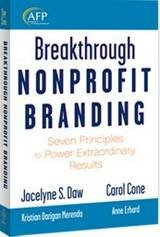Nonprofit branding: What, why and how
I’m often hesitant to mention “branding” — the core of my consulting work — in nonprofit circles. The reason is simple: It can be a conversation killer.
New research by Harvard’s Nathalie Kylander and Christopher Stone suggests why. Drawing on interviews across 41 organizations, Kylander and Stone identify four reasons for skepticism toward branding among nonprofits:
- Nonprofit leaders widely associate branding with “the commercial pursuit of monetary gain,” which debases their work.
- A brand is often seen as “peremptorily imposed from above” in lieu of a strategic planning process, which is viewed as more participatory.
- Some believe leadership vanity is a larger motivation for branding than fulfilling a mission.
- Large nonprofit “bully brands” overshadow weaker organizations and “give brand management a bad reputation.”
 These and other reasons for skepticism can’t change one fact: Any organization, nonprofit or for-profit, has a brand the moment it opens for business and people experience it. The question isn’t brand or no brand; it’s how well the brand is managed, communicated and experienced.
These and other reasons for skepticism can’t change one fact: Any organization, nonprofit or for-profit, has a brand the moment it opens for business and people experience it. The question isn’t brand or no brand; it’s how well the brand is managed, communicated and experienced.
Branding, the nonprofit way
In an era of proliferating nonprofits, declining public and donor resources and rising demand for charitable services, the competition for financial, volunteer and partner support is greater than ever. Nonprofits that ignore their brands risk irrelevance and indifference among their stakeholders. And yet most charitable organizations – knowingly or unknowingly – take the risk.
Beyond skepticism is a more basic reason for brand neglect: a widespread lack of understanding of what a successful nonprofit brand looks like and how to create one. Here we have some good news. Nonprofit leaders now have two recent and smart contributions toward a deeper understanding of the whats, whys and hows of creating and managing an effective nonprofit brand.
One is Kylander’s and Stone’s article, “The Role of Brand in the Nonprofit Sector,” in the Spring 2012 issue of the Stanford Social Innovation Review. The other is the 2011 book, “Breakthrough Nonprofit Branding: Seven Principles for Powering Extraordinary Results.”
Both works go far to defuse doubts about the value and desirability of a strong, well-managed nonprofit brand.
A nonprofit brand framework
Kylander and Stone, both with Harvard’s Hauser Center for Nonprofit Organizations, found the tools and models available to nonprofit brand managers rely too much on the brand language and approaches used in the for-profit sector.
To rectify that shortcoming, the authors offer a conceptual brand framework designed specifically to help nonprofit leaders better manage their brands. They call it the Nonprofit Brand IDEA, the culmination of an 18-month research project.
From their 73 interviews, they concluded the role of brand is changing among nonprofits:
A decade ago, the dominant brand paradigm in the nonprofit sector focused on communications…Branding was a tool for managing the external perceptions of an organization, a subject for the communications, fundraising, and marketing departments. In contrast, the emerging paradigm sees brand as having a broader and more strategic role in an organization’s purposes, methods, and values. Increasingly, brand is a matter for the entire nonprofit executive team.
The four principles of Nonprofit Brand IDEA comprise brand integrity, democracy, ethics and affinity:
- Brand integrity: “the organization’s internal identity is aligned with its external image and that both are aligned with the mission.”
- Brand democracy: “the organization trusts its members, staff, participants, and volunteers to communicate their own understanding of the organization’s core identity…(This) is largely a response to the growth of social media, which has made policing the brand nearly impossible.”
- Brand ethics: “the brand itself and the way it is deployed reflect the core values of the organization. Just as brand integrity aligns the brand with mission, brand ethics aligns both the organization’s internal identity and its external image with its values and culture.”
- Brand affinity: “the brand is a good team player, working well along side other brands…Organizations with the strongest brand affinity promote the brands of their partners as much as or more than they promote their own brands.”
Balanced against brand skeptics in the authors interviews were brand enthusiasts who believe a strong brand builds cohesion and capacity.
When an organization’s employees and volunteers all embrace a common brand identity, it creates organizational cohesion, concentrates focus, and reinforces shared values….Strong cohesion and high levels of trust contribute to greater organizational capacity and social impact.
The new nonprofit imperative
While Harvard’s Kylander and Stone contribute a useful model for constructing a nonprofit brand, they don’t offer much guidance in how to actually build one. That’s where the four authors of “Breakthrough Nonprofit Branding” come in.
Experienced in marketing, communications and public relations, the authors provide a comprehensive, step-by-step approach to branding the nonprofit, backed by a breadth of research and numerous case studies. Breakthrough branding, they argue, is “the new nonprofit imperative.”
More than simply a cosmetic makeover, at the base level, branding is the about identifying what your organization stands for—the unique, differentiated ideas that sets it apart. To build your brand requires forging an emotional and personal connection with your core stakeholders. Your brand must stand for a cause—something bigger than organizational activities, something your constituents care about and believe in. Yet, to truly break through calls for you to rally a community around your brand’s meaning and inspire action.
The book examines what the authors call “the Seven Principles of Breakthrough Nonprofit Branding” accompanied by examples of standout nonprofits of all sizes and locations putting the principles to work:
- Discover the authentic meaning of your brand: “A brand is the bridge between an organization’s unwavering mission and its evolving strategies.”
- Embed your brand meaning across the organization: A breakthrough brand (BNB) “embeds its brand meaning into every organization function, from people management to information technology systems.”
- Rally internal brand ambassadors: “A breakthrough brand continuously attends to the way its brand is expressed through the actions and attitudes of its internal stakeholders.”
- Develop 360° brand communications: “Utilizing a variety of integrated communications, including both online and off-line tools, the effective brand dynamically expresses its essence in ways that are meaningful and relevant to them.”
- Expand your brand by mobilizing an external community: “A BNB acts as a connector. It builds external communities, knowing that a critical mass of the right people mobilized behind its work is the most effective way to propel its cause.”
- Cultivate partners to extend your brand reach and influence: “A truly breakthrough nonprofit brand values strategic alliances that offer access to new expertise, relationships, and assets.”
- Leverage your brand for alternative revenue and value: “Breakthrough nonprofit brands use their brand meaning to extend reach, generate untraditional revenue, and build brand equity through their entrepreneurial endeavors.”
What about the small nonprofit?
While nonprofit leaders reading the article or book should be persuaded of the value in managing their brands, they may still resist because they lack money, staff and/or expertise. Small, under-funded nonprofits are the norm. Branding, even if considered desirable, can be seen as out of reach for the average organization.
Neither the article nor the book go far enough to address this perception. While branding, like fundraising, is really not a choice for any nonprofit, the question for the small nonprofit remains: How can we pull it off?
My reply is: Focus on what you can do and can afford and do the work of branding piece by piece over a period of months, even years. Take stock of what you can accomplish via staff, board or volunteer leadership and contributions. And raise or set aside some budget to supplement where needed with outside professional help, such as consultation on a branding approach, integration with your strategic plan, graphics design or marketing communications.
Branding can be expensive, but it doesn’t have to be. As the article and book authors make clear, there is also a cost in neglecting your brand — and a mission to be achieved by giving it your time and attention.

